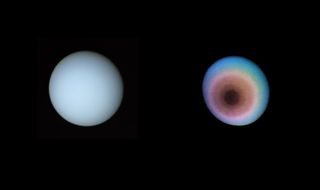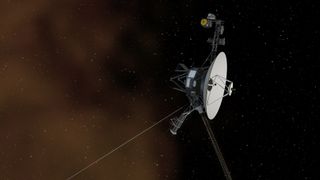Scientists may have solved a lingering mystery surrounding the ice giant Uranus and its weak radiation belts. The belts’ weakness may be related to the planet’s strangely tilted and unbalanced magnetic field, which could cause “traffic jams” for particles swirling around the planet.
The mystery dates back to Voyager 2’s visit to Uranus in January 1986, long before the probe left the solar system in 2018. The probe discovered that Uranus’ magnetic field is asymmetrical and tilted about 60 degrees from its axis of rotation. In addition, Voyager 2 discovered that Uranus’ radiation belts, made up of particles trapped by this magnetic field, are about 100 times fainter than expected.
The new research, based on simulations using data from Voyager 2, suggests that these two strange aspects of the ice giant are linked.
“Its magnetic field is unique in the solar system. Most planets have a strong intrinsic magnetic field, like Earth, Jupiter and Saturn. They have a very ‘traditional’ shape of magnetic field, known as a dipole,” lead author Matthew Acevski told Space.com. “This is the same shape of magnetic field that you would expect from an ordinary magnet. This is not the case for Uranus. Uranus’ field is very asymmetrical, and it becomes more and more so as you get closer to the surface of the planets.”
Related: Uranus and Neptune are actually similar blues, as revealed in “true” color images
Acevski explained that this research highlights how Uranus’ magnetic asymmetry distorts the structure of the planet’s proton radiation belts, particularly near the region traversed by Voyager 2.
“My hypothesis was that the magnetic asymmetry distorted the proton radiation belts, forming regions around the planet where the radiation belts were more compressed,” Acevski said, “and therefore with higher intensity; other regions where they were more spread out, leading to lower intensity.
“If Voyager 2 flew through a region where the radiation belts were more extensive, that could explain its observations of weaker-than-expected proton radiation belts.”
An anomaly in the solar system
Uranus, the coldest planet in the solar system and the seventh planet from the Sun, is an oddball among the other planets in our planetary system. The ice giant rolls like a cosmic ball, tilted in one direction at an angle of 97 degrees to the plane of its orbit. This means that when it rotates, it does so in a sort of “sideways” manner. It is the only planet in the solar system that does this.
This tilt, which is thought to be the result of a collision with an Earth-sized object in the distant past, causes Uranus to experience the most extreme seasons in the solar system, with a winter that lasts 21 years. Completing a full orbit once every 84 Earth years, Uranus is also one of only two planets in the solar system (the other being Venus) that orbits the sun in the opposite direction to all other planets.
About four times larger than Earth and about 19 times the distance from the Sun to our planet, Uranus is surrounded by 13 faint rings and at least 28 moons. Uranus also displays the northern lights, similar to Earth’s auroras, but due to the planet’s tilted magnetic field, they do not appear over its poles as they do over our planet, Jupiter, and even Saturn.
As with all planets with a magnetic field, charged particles are trapped around Uranus, creating radiation belts. But why these radiation belts appear so faint has remained a mystery for five decades.

The team’s simulation abandoned the idea that Uranus’ magnetic field acts like a dipole and used a more complex quadrupole magnetic field to reproduce its asymmetric nature.
This experiment revealed that particles accelerate and decelerate as they pass through regions with different magnetic fields. The changes in particle speed cause them to cluster in some regions and spread out in others. This effect only appears when a single, complex quadrupole magnetic field is included in the simulation, which is why it has never been observed before.
“We found that Uranus’s magnetic asymmetry could translate into regions of the planet where protons drift more slowly and are more compressed, and other regions where they drift more quickly and are more dispersed,” Acevski explained. “It’s similar to traffic jams on a ring road. When cars are moving more slowly, traffic becomes denser; if cars are moving faster, traffic is more dispersed.”
Acevski and his colleagues hypothesize that when Voyager 2 visited Uranus, it passed through a weak region of the ice giant’s radiation belt.
“We projected Voyager 2’s trajectory onto this profile and found that the spacecraft had indeed passed through a ‘rapid drift’ region, which would imply that it should have observed a lower-than-normal proton radiation intensity,” Acevski said. “Importantly, our particle simulations show that this result represents a maximum variation of about 20% in proton intensity around the planet.”
This means that the team’s model cannot fully account for the 100 times weaker intensity observed by Voyager 2.
“It is possible that the primary effect that caused these much weaker proton radiation belts could have been compounded by the effect we discovered,” Acevski continued. “We were extremely surprised by the results. It is astonishing how much influence magnetic asymmetry can have on the structure of the radiation belts. This is something that was not known before.”

Acevski stressed that the results obtained by himself and his team could help inform future space missions to Uranus. So far, Voyager 2 is the only spacecraft to have visited the ice giant. This means that direct data on the planet is extremely limited.
NASA is planning to launch a mission to Uranus as early as 2030. Such a mission could allow the conclusion of this simulation to be experimentally verified.
“To verify these simulations, we need a flagship mission to Uranus to get new in situ measurements of the planet over several years rather than just hours like Voyager 2 did,” Acevski said. “A new mission could also allow us to discover new physics that we couldn’t even predict with simulations.”
“Since this is a planet with a magnetic field that we have never seen before, it is quite possible that completely new phenomena will be discovered, which would expand our understanding of planetary science.”
Acevski is certainly not finished with this strange world of the solar system. The ice giant particularly fascinates the researcher.
“Uranus presents a unique challenge for science, one that I find very fun to tackle. It’s really fascinating how much can be discovered with so little data, and we’re literally just scratching the surface,” Acevski concludes. “To date, few people study the icy giant planets, Uranus and Neptune, despite the fact that they have such strange characteristics, particularly in their magnetic fields. So it’s very exciting for me to draw attention to the strange phenomena that can occur there.”
The team’s research was published in June in the journal Geophysical Research Letters.